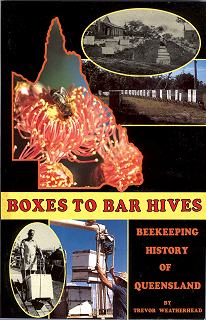This is however, a long term project! I don't get much chance for reading as I spend a considerable portion of my time maintaining and improving this website. Many books are used as reference and as such have not been read from cover to cover.
I expect to re-read a few bee books that I already have about 350 (at 1999) and I expect I will purchase one or two in the future, at 2005 the number was nearer 400.
My Bee Book... William Charles Cotton M.A.
Written 1842
(Read December 2000)
A collection of two or three page essays on various bee subjects. Some unusual old woodcuts. An oddity in many ways, difficult reading due to "floury" language. (Not recommended for beginners.)
A Living From Bees... Frank C. Pellet
Written 1944
(Read March 2001)
A rather old fashioned book dealing with American beekeeping. Interesting for experienced beekeepers, but not recommended reading for beginners.
Beekeeping in the swarming season... by George Davis
This book was originally written in 1976 after 50 years beekeepingexperience.
(Read March 2001)
Some of the methods in it may appear novel, but all of those that he considers are his ideas were in fact written about between the years 1860 and 1900 by Samual Simmins. No mention is made of this author in the list of books that he says that he has read and been influenced by.
The net nursery cage is merely his name for a queen isolation cage which has been an item of beekeeping equipment since frames were invented.
He displays an inability "read a colony" and to plan his swarm control and substitutes the very labour intensive method of watching the hives daily. This may be pleasant for the perpetrator, but is not very practical.
His advice on queen rearing is a mixture of good practice, poor planning and bad management, that stems from a general lack of understanding and certainly not what he should have understood by reading Snelgrove's, Wedmore's and Bro. Adam's books (which he alludes to). For instance... He goes to great lengths to prepare larvae for raising queens then spoils the effort by delaying the insertion of the prepared frame and placing the frame between other frames that contain only sealed brood. This means that his nicely prepared larvae are disadvantaged and inadequately fed.
Not a book I would recommend to beginners. Having been so negative about it, I enjoyed reading it, it is typical of many books written around 1950. I read this book at the behest of the late Stan Williams, prior to his visit to Gormanston in 2001.
Beeswax... William Cogshall & Roger Morse
Written 1984
(Read May 2001)
An interesting book, but more for the large commercial operator or beekeeping equipment manufacturer. There is not much in it that is of direct use by the small or hobby beekeeper. There are good descriptions of large scale wax filtration, but I doubt if the methods could be scaled down for private use. Not the book to read if you are looking for information on how to clean up a few cakes of wax.
Boxes To Bar Hives... Trevor Weatherhead
Published 1986, ISBN 0 86774 009 4
(Read August 2005)
Trevor gave me a copy of this book at Apimondia 2005, he thought that the historic information on Australian beekeeping associations, would be of little interest, but I enjoyed reading all of it. The book deals with individuals and companies and because of my beekeeping equipment manufacturing past I was able to draw parallels to the UK equipment trade. I await the next instalment with interest. I am not sure of the availability of this item through the book trade, but I believe that copies are available from The Queensland Beekeepers Association (QBA. The QBA can be contacted at qba@hypermax.net.au The history was published on the occasion of the 100th anniversary of the QBA in 1986.
